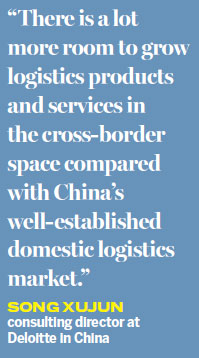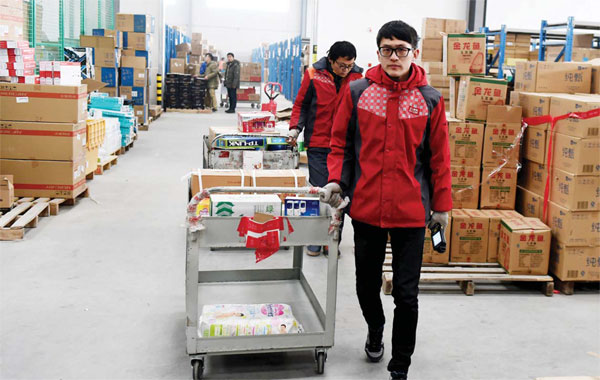Bringing the world home to China

Popularity of ordering products around the globe spurs growth of sophisticated logistics providers
China's booming cross-border e-commerce space is creating an exciting new market for logistics providers to transport goods from foreign retailers to Chinese consumers.
The scale and novelty of this logistics market are harbingers of fat profits, pushing logistics providers to constantly innovate, invest heavily in warehousing, and develop advanced IT systems to improve speed and reliability while cutting costs.
| One of JD.com's logistics centers, in Zhengzhou, Henan province. The e-commerce company has set up an overseas purchasing arm, JD Worldwide, to buy products it identifies as being in high demand among Chinese customers. These are then warehoused in China to be quickly shipped to buyers. Provided to China Daily |
This trend came about thanks to measures by the government in 2014 to provide incentives for cross-border e-commerce. In 2014, China's cross-border imports were worth 100 billion yuan ($15 billion; 13.5 billion euros), growing to 150 billion yuan the following year and are forecast to hit 210 billion yuan in 2016, according to estimates from Chinese intelligence firm Iresearch.
Even more significant is the growth potential. The global cross-border e-commerce market stood at $230 billion in 2014, and is projected to grow to $1 trillion by 2020, according to joint research by Accenture and AliResearch, Alibaba Group's research arm.
"There is a lot more room to grow logistics products and services in the cross-border space compared with China's well-established domestic logistics market," says Song Xujun, consulting director at Deloitte in China. "Secondly, in the cross-border scenario ... logistics companies have more bargaining power with e-commerce platforms."
The advantages will go to those who cut costs. That is particularly so since higher cross-border e-commerce retail taxes were introduced in April, increasing sellers' costs.
Growing economies of scale are seen as the key driver to keeping costs low by companies such as Hangzhou-based Dolphin Supply Chain, founded in 2003. Its monthly revenue is now around 150 million yuan.
The company has established a streamlined service. This is how it works: Dolphin's contract truck drivers collect goods from retailers and deposit them at Dolphin's overseas warehouses from which they are flown to warehouses in China. Dolphin's IT system monitors product collection times to ensure purchases are delivered to its overseas warehouses within hours. Around one additional day is required to fly the goods to China, with a further day needed to reach the customer. Total delivery time can be as quick as three days.

"We have invested heavily in creating our own ecosystem of logistics infrastructure serving the cross-border leg of the delivery process, as it is a market that started from scratch," says David Lee, CEO of Dolphin Supply Chain. "Our own contract fleet of truck drivers and cargo planes enable us to have complete control of the timing of delivery, and to monitor and ensure products are kept in their optimal conditions."
Dolphin has warehouses in the United States, Japan, Hong Kong, Australia, the United Kingdom, Germany and Poland - strategically chosen to be close to food suppliers, the firm's focus industry. "We send all our items by plane to get them to customers as soon as possible," says Lee.
Hangzhou-based Beibei, one of China's largest e-commerce suppliers of baby products, has also built overseas warehouses in Asia and Europe, and in Hangzhou, Ningbo, Guangzhou and Tianjin.
Ke Zunyao, its chief operating officer, says with products stored in its Chinese warehouses, the company can dispatch them on the same day if orders come in before 4 pm.
Beibei checks goods three times between entering and leaving its warehouses, and food products are packaged according to strict guidelines. That cannot be guaranteed if logistics were handled by third-party providers.
China's two largest e-commerce platforms by volume are Alibaba and JD.com.
Alibaba has built its own logistics network, Cainiao, which links Alibaba with a consortium of logistics providers, including 49 cross-border delivery partners including 4PX, Royal Mail and SingPost. According to Alibaba's estimates, these delivery partners together have 74 cross-border warehouses globally that can support the delivery of 4 million packages per day, covering 224 countries and regions.
JD.com has set up an overseas purchasing arm, JD Worldwide, to purchase products it identifies as being in high demand among Chinese customers. These are then warehoused in China to be quickly shipped to buyers.
The e-commerce import boom has also benefited air cargo operators. International Airlines Group's cargo division saw 40 percent growth in the amount of goods it handled last year, mainly driven by large volumes of high-end fashion items shipped from the UK.
Daniel Johnson, global products manager at IAG Cargo, says the volume of goods flown to Shanghai, mainly from Milan, Frankfurt and Madrid, more than doubled compared with 2014.
Before 2014, getting foreign goods to China was expensive and complex, relying on postal service providers or express parcel delivery firms such as DHL and UPS, which have set up their own service points in China.
Mail can be relatively cheap but also slow. Express delivery firms are quicker but also more expensive. So a new breed of operators - parcel forwarding firms - has emerged in recent years.
Big names such as 4PX Worldwide Express and XLobo, logistics arm of the Chinese e-commerce platform Ymatou, collect and bundle individual parcels at overseas locations and ship them to China as a single consignment. Although they still rely on postal and express delivery services, their profits come from the economy of scale in handling high volumes.
The 2014 e-commerce reforms included setting up bonded warehouses in seven pilot locations. Products can be transported to these warehouses in bulk and clear customs when they are dispatched to customers.
The benefits of the system, including tax advantages, encouraged logistics firms and e-commerce platforms to set up their own bounded warehouses within the designated zones.
Jim Tompkins, CEO of US-based Tompkins International Supply Chain Consulting, says another popular strategy is to establish a hub in the country of origin where individual orders can be packed in a single container for shipment to China. "It avoids the need to hold inventory overseas where it may have a risk of not being sold," he says.
New investments by logistics firms and e-commerce platforms are now squeezing the market share of firms that do not have their own logistics infrastructure. "The market is experiencing a process of consolidation, and the parcel-forwarding companies may in the future find it hard to keep their market share," says Deloitte's Song.
Fox Chu, managing director of Accenture's freight and logistics operation, says a key trend is the growth of the one-stop-shop approach, whereby a service provider not only handles end-to-end logistics on behalf of retailers, but also helps them with digital marketing and financial and other services.
Chu says such flexible service providers go "beyond being merely a logistics service provider, they position themselves as an e-commerce trade expert".
One such firm is London-based Avenue 51, an e-commerce consulting firm with its roots in logistics. It has developed an IT system that helps British retailers find the best delivery route to Chinese customers by using a product's size, weight, price and type, and matching these with other factors such as volume and time requirements.
Eric Wang, co-founder of Avenue 51, says the new cross-border e-commerce tax changes effectively place more demand for logistics providers to understand the best logistics route to suggest to customers. Some products save costs using the cross-border e-commerce route, and others the traditional postal route.
cecily.liu@chinadaily.com.cn
(China Daily European Weekly 05/20/2016 page29)
Today's Top News
- Takaichi must stop rubbing salt in wounds, retract Taiwan remarks
- Millions vie for civil service jobs
- Chinese landmark trade corridor handles over 5m TEUs
- China holds first national civil service exam since raising eligibility age cap
- Xi's article on CPC self-reform to be published
- Xi stresses improving long-term mechanisms for cyberspace governance































